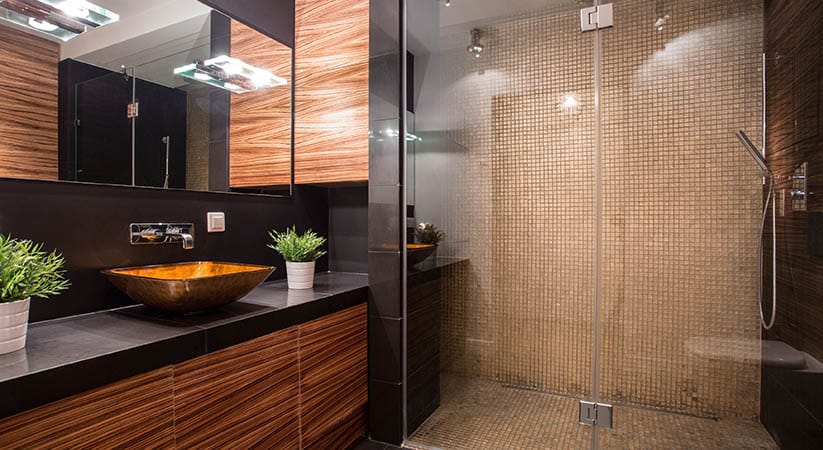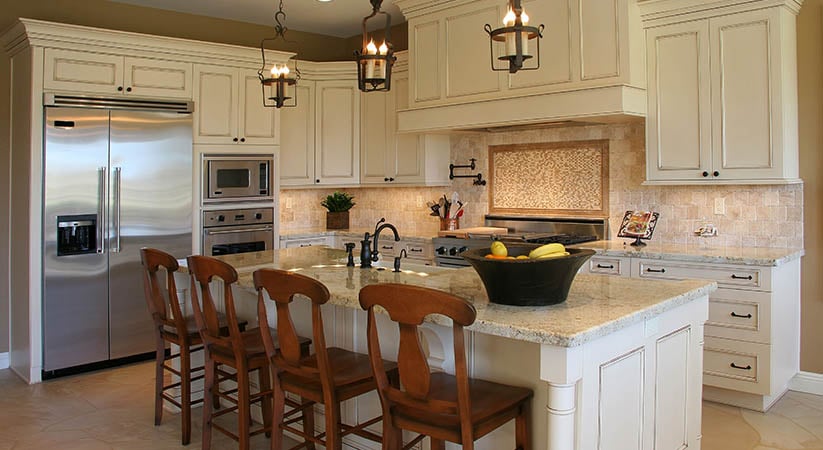A bathroom vanity can be a prominent part of your bathroom if you choose it correctly. Moreover, you can avoid a full bath remodel by replacing your vanity and painting the walls of your bathroom.
Choosing A Bathroom Vanity
Pick A Size
Every inch of space is important in a bathroom especially if it’s a small bathroom. So, before selecting anything, you should measure the area where you want the vanity to be installed. This will give you an idea of the vanity size you need.
When measuring, keep the door clearance of the bathroom door and the shower door as well. You don’t want the vanity doors to hit the doors or other cabinets.
Vanities are usually measured by their width, but you can also get different length sizes as well. Generally, there are three sizes of vanities
- Small vanities: They are best for powder rooms and can be between 18-36 inches in width.
- Medium vanities: You can use a medium vanity for a guest bath, a child’s bath, or a medium-sized bathroom. You can choose between 30 to 60 inches of width.
- Large vanities: When you have a bigger bathroom, you can choose large vanities of width sizes from more than 60 inches.
Single Or Double Sink Vanity
Single sinks are commonly used in smaller vanities. But if your vanity is bigger than 25-30 inches, you have the choice to get a double sink for your vanity.
Double sinks are ideal if you will share the bathroom with another family member or your spouse. Two sinks in a vanity can reduce the counter space you may have with a single sink, so if you need the counter space and have a bigger bathroom, you can also consider two vanities with a single sink each. However, single vanity with a double sink appears better.
The Type Of Vanity
You will be puzzled with three types of vanities: freestanding, floating, and corner vanities.
Freestanding Vanities
Freestanding vanities are the most common and standard types of vanities. They sit directly on the floor with their legs. These are considered more durable and you can choose heavier materials.
Floating Vanities
Floating vanities are new types of vanities that are mounted to a wall. They don’t have feet and there is free space between the end of the vanity and the floor. These vanities are preferred by people who have smaller bathrooms because the floating style gives the illusion of space.
Corner Vanities
Corner vanities are placed at the corner of the bathroom. They are usually freestanding vanities and make the corner of your bathroom more useful. They can be used in bathrooms where there is less space for a vanity. You can fit this vanity in the corner saving space.
Vanity Materials
A vanity has usually three different materials: the base material of which the vanity is made of like wood, the countertop that is placed on top of the vanity, and the sink.
Vanity Base And Cabinets Materials
Solid Wood Or Natural Wood
Solid wood is the strongest and most durable material for bathroom vanities. Wood can expand and contract with temperature changes and can be damaged with moisture, but it’s still considered the best option for bathroom vanities because homeowners and home buyers prefer solid wood for vanities and bathroom & kitchen cabinets.
You can choose from many types of natural wood like oak, walnut, cherry, ash, and others. With the types of wood available, you can choose an option that’s within your budget. However, keep in mind that solid wood is a costly vanity material in general.
Solid Plywood
Wood veneers are glued into many layers to form a thick and durable material. It’s a viable mid-range option with respect to cost and quality. You can select from different plywood thicknesses. More thick plywood means more durability.
Solid plywood resists expansion and contraction with temperature changes and warps with moisture. So, if you control the moisture, it can last for decades.
Medium Density Fiberboard (MDF)
MDF is an engineered material made with wood pieces and fibers bonded with resin or wax. It may appear similar to particleboard, but it’s denser and more durable. MDF is a cost-effective option for vanities and cabinets.
MDF last long if it’s finished and painted because it can resist moisture. However, if it’s not painted, moisture can penetrate into the materials and cause damage. Moreover, MDF is made with chemicals that can release formaldehyde – a cancer-causing material.
So, if you choose MDF for your bathroom vanity, make sure to finish and paint it to avoid moisture and the release of formaldehyde.
Countertop Material
Laminate
Laminate is the most inexpensive material you can select for your vanity. They are not durable and will require replacement soon. However, if your vanity is a powder room or guest room, then laminate will be fine.
Ceramic Or Porcelain Tiles
You can have ceramic or porcelain tiles on your vanity. These are resistant to moisture and are easy to clean. However, grout lines can wear if you’re not careful. Porcelain tiles are more durable but ceramic tiles crack easily. Their replacement is easy.
Solid Surface
They can give the appearance of a natural stone at a medium-cost range. Solid surface slabs are made with acrylic and polyester particles bonded with resins. They are cost-effective and durable for a heavy-use bathroom. Moreover, you can get away with lower costs if you want to remodel and sell your house.
Natural Stone
Natural stones provide luxury to a bathroom and also cost higher than most vanity top materials. Homeowners commonly use marble, granite, slate, soapstone, limestone, travertine, and others. All the natural stones are porous and require sealing for resisting moisture. Moreover, you need to reseal the vanity top every few years.
Quartz
Quartz is an engineered stone composed of quartz and resins. Its cost is similar to granite and is as durable. If you’re doing bathroom renovations for yourself and have the budget, select quartz. Plus, quartz is a better material for bathrooms because it’s non-porous and resistant to moisture and stains.
Sink
- Drop-in sink: These sinks are common in older and newer homes alike. They are also called self-rimming sinks because no outer layer is required as the sink’s outer ends act as the outer layer of the sink. They can be installed in any type of vanity top material.
- Under-mount sink: This is a clean-looking sink installation that is seen in newer homes mostly. They are only installed into solid surface vanity tops and don’t offer much for people who have a vanity top of laminate or tile.
Paint Finish
You can select any color on your vanity, but there are three kinds of paint finishes. A satin finish is matte and reflects the minimum amount of light. Semi-gloss is shinier than satin and reflects light fine. Moreover, gloss is the most reflective. You can choose any of these finishes, but if you require a finish that aids in cleaning, you should choose the gloss finish because cleaning becomes easier with it.
Conclusion
The selection of a bathroom vanity should start with the size. For a bigger-sized vanity, you can choose double sink. Choose sturdy materials like wood as the base materials and quartz as the vanity top for a long-lasting vanity. If you want to save money, select MDF and tile. Find bathroom remodelers who can suggest designs that match your bathroom style. abbruz



